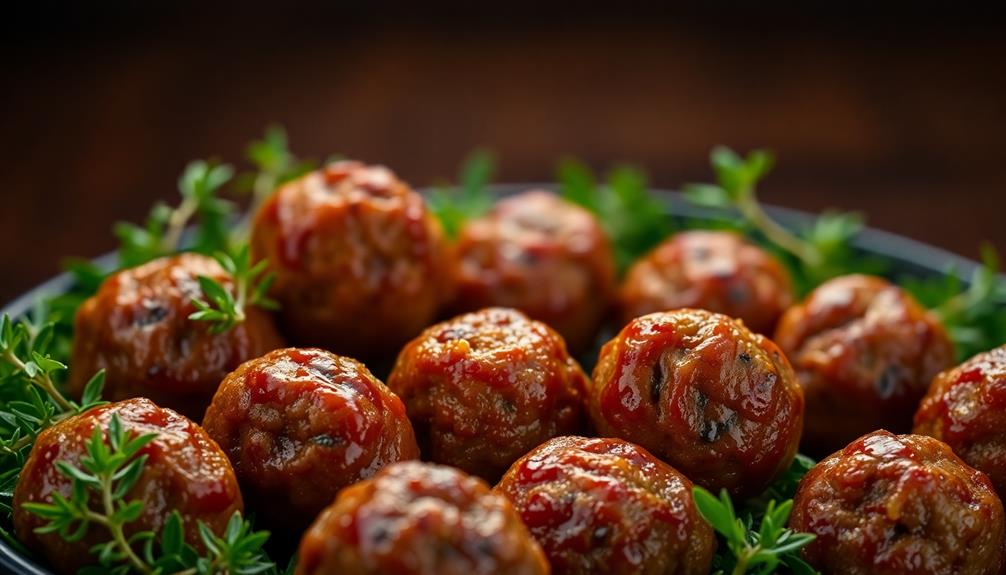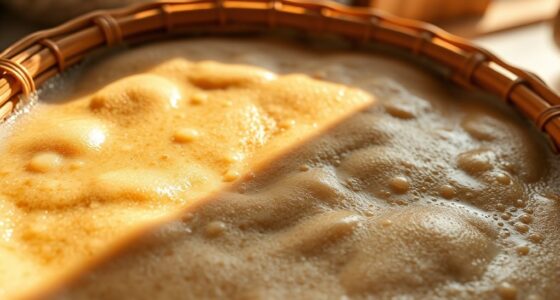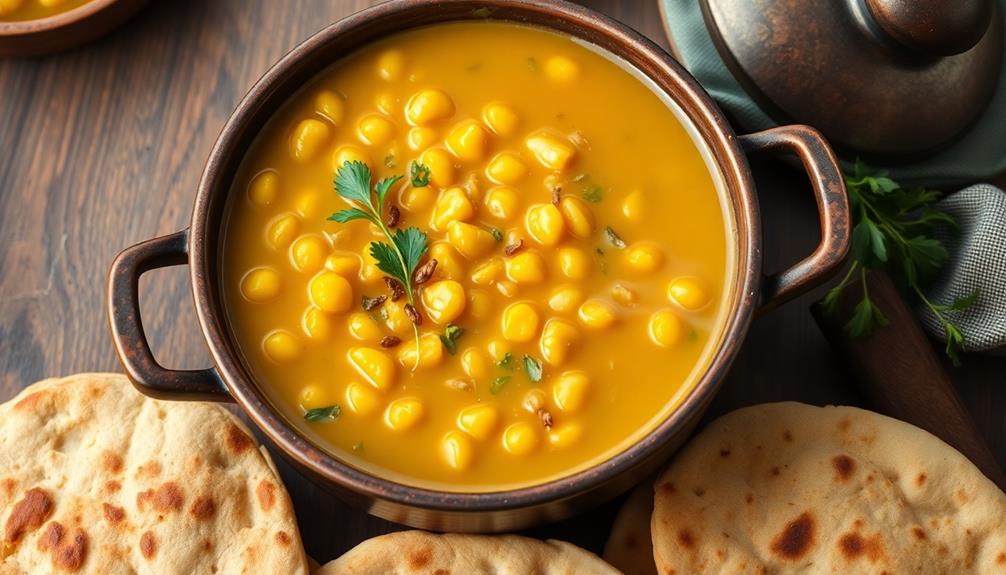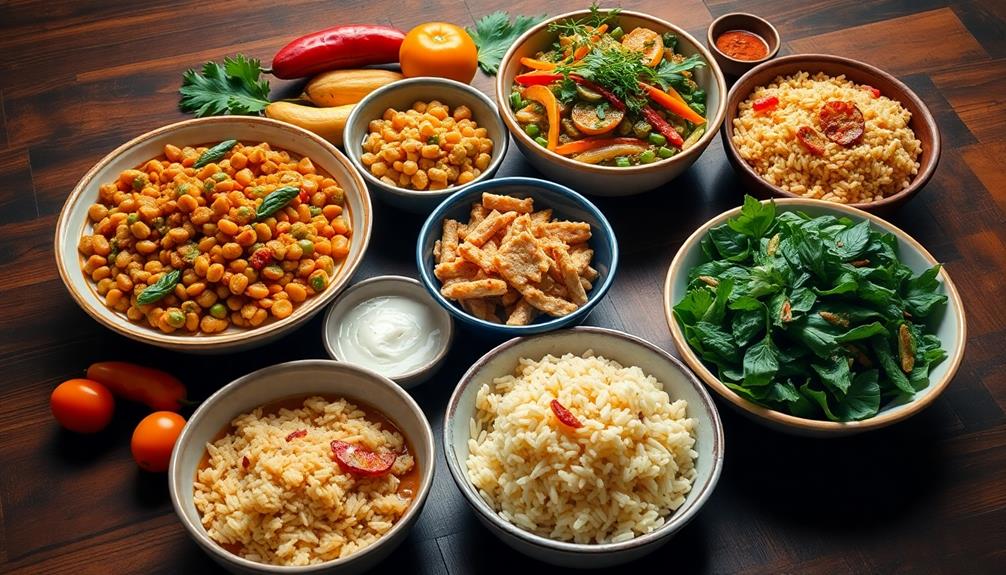Ye'doro Alicha is a cherished chicken stew rooted in ancient Ethiopian traditions. This comforting dish combines tender chicken with a complex blend of spices like turmeric, ginger, and paprika, creating a mild yet inviting flavor. Typically served over injera, a spongy flatbread, or with steamed rice, Ye'doro Alicha is a beloved part of Ethiopian cuisine, often enjoyed during special occasions and gatherings. The recipe can be customized with various vegetables to suit different preferences. This dish's lasting appeal comes from its ability to evoke nostalgia and warmth, making it a beloved choice for many. If you'd like to learn more about the dish's history and cooking process, keep reading.
Key Takeaways
- Ye'doro Alicha is a traditional Ethiopian chicken stew with a mild and comforting flavor profile, reflecting the country's rich culinary heritage.
- The dish is commonly served during festive occasions and community gatherings, symbolizing the importance of family and shared meals in Ethiopian culture.
- The recipe combines tender chicken with a blend of aromatic spices like turmeric, ginger, and garlic, creating a harmonious and inviting taste.
- Ye'doro Alicha is typically served with injera, a spongy sourdough flatbread, or steamed rice, encouraging traditional eating methods.
- The versatility of the dish allows for customization with various vegetables and spice levels, making it appealing to a wide audience.
History
Ye'doro Alicha's origins can be traced back to the ancient culinary traditions of Ethiopia. This beloved chicken stew has been a staple dish in the region for centuries, passed down through generations and evolving with local ingredients and techniques.
The name "Ye'doro Alicha" translates to "mild chicken stew," reflecting the dish's signature flavor profile – a harmonious blend of aromatic spices, tender chicken, and a rich, creamy broth. Over time, the recipe has been adapted to suit diverse tastes, with variations incorporating different vegetables, herbs, and levels of spiciness. For those looking for a vegetarian alternative, Ye’doro Alicha can also be made using chickpeas instead of chicken, resulting in a delicious chickpea stew recipe. This adaptation offers a hearty and satisfying option for those seeking a meat-free meal. Whether made with chicken or chickpeas, Ye’doro Alicha continues to be a beloved and versatile dish in Ethiopian cuisine.
Traditionally, Ye'doro Alicha was often served during festive occasions, such as religious holidays or community gatherings. It remains a cherished part of Ethiopian cuisine, symbolizing the country's rich culinary heritage and the importance of sharing meals with loved ones.
Today, this comforting dish continues to be a beloved staple, enjoyed by people across Ethiopia and around the world.
Recipe
Ye'doro Alicha is a traditional Ethiopian vegetarian dish made with yellow split peas, onions, and a blend of aromatic spices. This comforting stew is often served with injera, a spongy sourdough flatbread, making it a staple in Ethiopian cuisine.
The harmonious combination of the tender split peas, the fragrant spices, and the caramelized onions creates a deeply flavored and satisfying dish. Ye'doro Alicha isn't only delicious but also a nutritious and filling option for those seeking a plant-based meal.
- 1 cup yellow split peas, rinsed
- 1 large onion, diced
- 3 cloves of garlic, minced
- 1 tablespoon grated ginger
- 1 teaspoon ground turmeric
- 1 teaspoon ground cumin
- 1 teaspoon ground coriander
- 1 teaspoon paprika
- 1 tablespoon tomato paste
- 4 cups vegetable broth
- Salt and black pepper to taste
- Chopped cilantro for garnish (optional)
In a large pot, sauté the onions over medium heat until they're translucent and lightly caramelized, about 10 minutes.
Add the garlic and ginger and cook for an additional minute, until fragrant. Stir in the turmeric, cumin, coriander, and paprika, and cook for 2-3 minutes to toast the spices.
Add the rinsed split peas, tomato paste, and vegetable broth. Bring the mixture to a boil, then reduce the heat and simmer for 30-40 minutes, or until the split peas are tender and the stew has thickened.
Season with salt and black pepper to taste.
To achieve the best texture, be sure to stir the Ye'doro Alicha occasionally during the simmering process. The longer the stew cooks, the more the flavors will meld together, creating a rich and satisfying dish.
Serve hot, garnished with chopped cilantro if desired, and accompanied by injera or your choice of bread.
Cooking Steps
First, rinse the chicken thoroughly under running water to remove any impurities.
Next, sauté the onions and garlic in a pot to build the flavor base.
Then, add the spices and broth, cover, and let the dish simmer until the chicken is tender and cooked through.
Serve this delicious Ye'doro Alicha with traditional injera bread or fluffy white rice.
Step 1. Rinse Chicken Thoroughly in Water
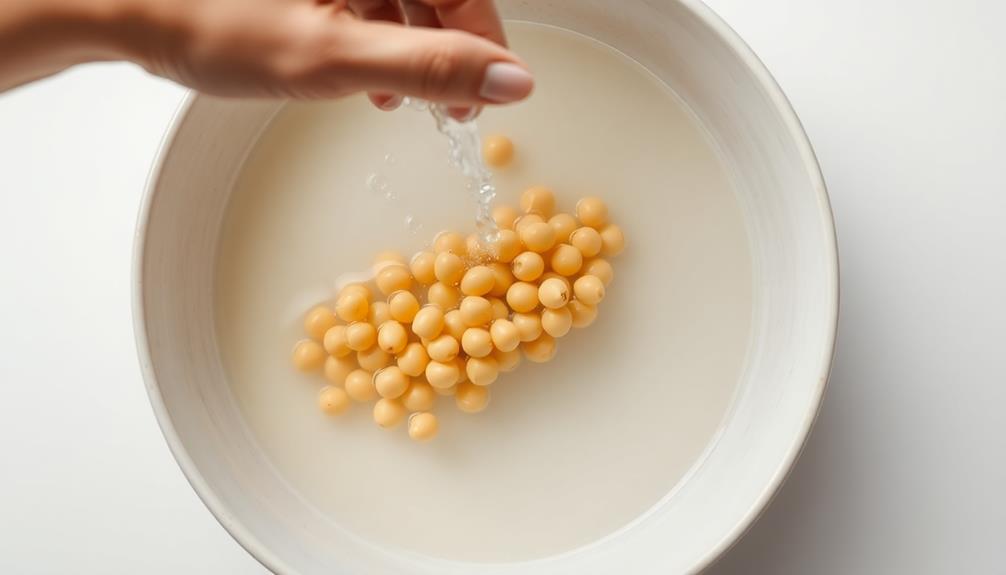
Have you thoroughly rinsed the chicken under cool running water? This crucial step helps remove any dirt, blood, or impurities from the surface of the meat. Rinse the chicken, both inside and out, ensuring it's completely clean before proceeding with the rest of the recipe.
Use your hands to gently rub the skin and cavities, dislodging any stubborn debris. Avoid scrubbing too hard, as this can damage the delicate flesh.
Once the chicken is visibly clean, give it a final rinse to wash away any remaining particles. Pat the chicken dry with paper towels, making sure to soak up any excess moisture. This step is essential for achieving the best texture and flavor in your Ye'doro Alicha.
Step 2. Add Onions and Garlic
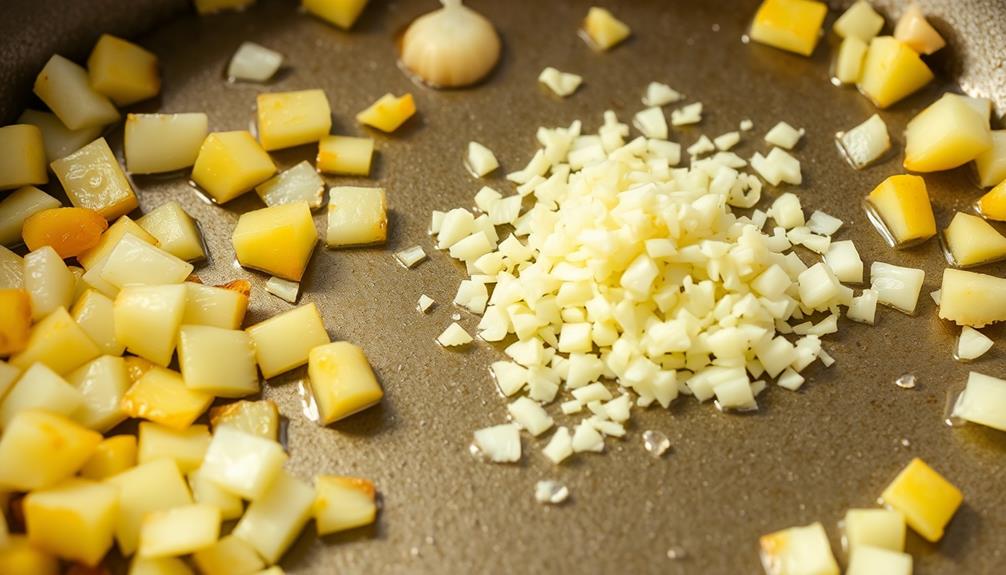
Once the chicken is rinsed and patted dry, it's time to start building the flavors of your Ye'doro Alicha. Grab a large pot and place it over medium heat. Add a few tablespoons of oil or butter, and let it heat up.
Next, it's time to add the onions. Slice them into thin strips or chop them into small pieces, whatever you prefer. Toss the onions into the pot and let them sizzle, stirring occasionally, until they're soft and translucent, about 5-7 minutes.
Now, add the garlic. Mince or press 3-4 cloves of garlic and add them to the pot. Let the garlic cook for 1-2 minutes, until it becomes fragrant. Be careful not to let it burn, as that can make the flavor bitter.
Your aromatic base is now ready! The onions and garlic have laid the foundation for the rich, comforting flavors of your Ye'doro Alicha. Get ready to add the next ingredients and watch your stew come together.
Step 3. Add Spices and Broth

Next, add the spices to the sizzling onions and garlic. Throw in a teaspoon each of ground cumin, coriander, and turmeric.
These warm, earthy spices will infuse the dish with flavor. Don't forget to add a pinch of black pepper and a dash of paprika for a touch of smokiness. Stir everything together and let the aromas fill your kitchen.
Now, it's time to add the broth. Pour in about 4 cups of chicken or vegetable broth, making sure to scrape up any browned bits from the bottom of the pot.
This will create a rich, flavorful base for your stew. Bring the mixture to a boil, then reduce the heat and let it simmer for 15-20 minutes, allowing the flavors to meld.
The stew should thicken slightly as it cooks. Taste and adjust the seasoning as needed, adding more spices or a bit of salt to suit your preferences.
Step 4. Simmer Until Chicken Is Tender

With the flavorful broth simmering, gently add the chicken pieces to the pot. Let the chicken simmer until it's fork-tender, about 25-30 minutes. Keep an eye on the pot, stirring occasionally to ensure the chicken cooks evenly. The rich, aromatic broth will slowly tenderize the chicken, infusing it with the warm spices.
As the chicken simmers, the flavors will meld together, creating a comforting and satisfying stew. Breathe in the enticing aroma of the simmering spices – they'll make your mouth water in anticipation.
Once the chicken is tender, you can test it by gently piercing a piece with a fork. If it slides off the bone easily, it's ready.
Reduce the heat to low and let the stew continue to simmer for another 10 minutes, allowing the flavors to fully develop. This final simmering step ensures the chicken is meltingly tender and the stew has a deliciously thick consistency.
Now, your Ye'doro Alicha is almost ready to serve!
Step 5. Serve With Injera or Rice

Serve the tender, fragrant chicken stew over a bed of fluffy injera or steamed rice. Injera is a spongy, sourdough flatbread that's a staple in Ethiopian cuisine. It's the perfect vehicle for scooping up the savory stew.
If you prefer, you can also serve the alicha over a mound of fragrant basmati or jasmine rice.
To serve, place a generous portion of the chicken stew in the center of a plate or shallow bowl. Arrange the injera or rice around the stew, allowing plenty of surface area for dipping and scooping.
Encourage your guests to use their hands to tear off pieces of the injera and scoop up the alicha. The soft, tangy bread pairs beautifully with the warmth and richness of the chicken.
For a complete meal, you can also offer additional vegetable sides, such as gomen (collard greens) or kik alicha (yellow split pea stew). Enjoy this authentic Ethiopian feast with family and friends.
Final Thoughts
Ye'doro Alicha is a delectable Ethiopian vegetarian stew that showcases the vibrant flavors of turmeric, ginger, and garlic. Whether you serve it with the traditional injera or opt for a side of fluffy rice, this dish is sure to delight.
The complex blend of spices creates a harmonious symphony on your palate, transporting you to the heart of Ethiopian cuisine. As you savor the final bites, reflect on the care and attention that went into crafting this nourishing meal.
Ye'doro Alicha is more than just a dish – it's a culinary journey that celebrates the rich cultural heritage of Ethiopia. So, don't be surprised if you find yourself craving it long after the last spoonful.
With its comforting flavors and easy-to-follow recipe, Ye'doro Alicha is a dish you'll want to revisit time and time again, sharing it with family and friends to create lasting memories.
Frequently Asked Questions
How Long Does It Take to Prepare Ye'doro Alicha?
To prepare this dish, you'll need about 45-60 minutes. The active cooking time is fairly quick, but allowing the flavors to meld is key for the best results. Don't rush the process – take your time and enjoy the process.
Can Ye'doro Alicha Be Made With Other Types of Meat?
Yes, you can make this dish with other types of meat. While chicken is the traditional option, you can substitute it with beef, lamb, or even lentils to create a delicious and versatile stew.
Is Ye'doro Alicha Suitable for Vegetarians or Vegans?
Yes, you can easily make a vegetarian or vegan version of this dish by substituting the meat with your preferred plant-based protein. Just adjust the seasonings to suit your dietary needs.
What Are the Health Benefits of Ye'doro Alicha?
The health benefits of this dish depend on its ingredients. It may provide protein, vitamins, and minerals, but you'd need to check the specific recipe to understand its nutritional value for vegetarians or vegans.
Can Ye'doro Alicha Be Frozen and Reheated Later?
Yes, you can absolutely freeze and reheat a cooked dish later. Freezing helps preserve the flavors and nutrients, and reheating it allows you to enjoy a delicious meal with minimal effort whenever you're ready.

